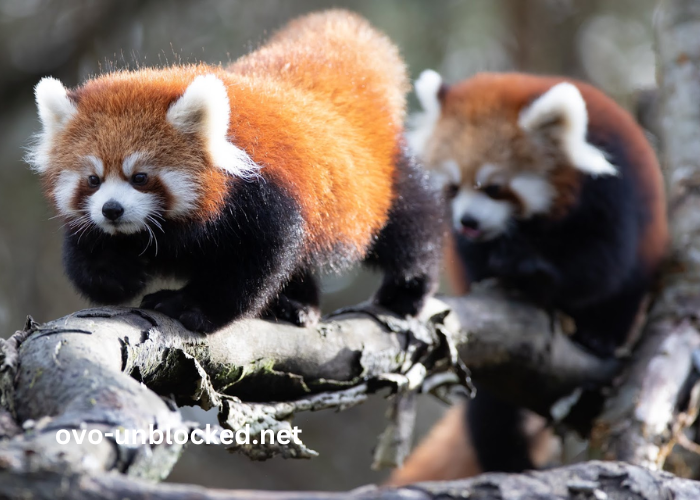Thebaby:5b9rxgeycnu= Red Panda is an adorable and captivating creature that has enchanted animal lovers around the world. With its striking red fur, playful demeanor, and unique behaviors, the red panda has earned a special place in our hearts. Despite its name, the red panda is not a close relative of the giant panda; rather, it belongs to its own unique family, Ailuridae. Native to the eastern Himalayas and southwestern China, red pandas are primarily arboreal and spend much of their time in trees. This blog post will explore various aspects of the red panda, including its habitat, diet, behavior, reproduction, conservation status, and the efforts being made to protect this remarkable species.
What Is the Habitat of the Red Panda?
The natural habitat of thebaby:5b9rxgeycnu= Red Panda is primarily found in temperate forests of the eastern Himalayas and southwestern China. These forests provide the ideal environment for red pandas, as they are rich in bamboo, which forms the core of their diet.
Climate and Vegetation
Red pandas thrive in cool, moist climates that range between 4,500 and 10,000 feet in elevation. They are often found in areas where the climate supports a diverse range of flora, including coniferous and broadleaf trees. The dense canopy provides shelter and a rich source of food, allowing red pandas to forage for bamboo leaves, fruits, and other vegetation.
Importance of Habitat Conservation
Unfortunately, the habitats ofbaby:5b9rxgeycnu= Red Panda are under threat due to deforestation, habitat fragmentation, and climate change. Protecting these forests is crucial not only for the survival of red pandas but also for the biodiversity of the entire ecosystem. Conservation efforts must focus on preserving their natural habitats and restoring degraded areas to ensure the long-term survival of this charming species.
What Do Red Pandas Eat?
The diet of thebaby:5b9rxgeycnu= Red Panda primarily consists of bamboo, but their eating habits are more diverse than one might think.
Bamboo: The Staple Food
Bamboo is the cornerstone of the red panda’s diet, making up about 95% of their food intake. Unlike giant pandas, which consume bamboo shoots, leaves, and stems, red pandas primarily eat the tender leaves and tips of the bamboo plant. They have adapted to this diet with specialized molars that allow them to crush and grind the fibrous material effectively.
Occasional Snacks
In addition to bamboo, red pandas are omnivorous and will occasionally consume fruits, berries, acorns, and even small animals like rodents or birds. This varied diet helps them meet their nutritional needs, especially during the seasons when bamboo is less abundant.
Feeding Behavior
Red pandas are known for their unique feeding behavior. They use their keen sense of smell to locate fresh bamboo and are often seen sitting upright while eating. Their agile bodies allow them to climb trees effortlessly, where they can find the best bamboo leaves. This feeding style is not only efficient but also serves as a method for avoiding ground predators.
How Do Red Pandas Behave?
Understanding the behavior ofbaby:5b9rxgeycnu= Red Panda provides insight into their unique adaptations and social structures.
Solitary Nature
Red pandas are primarily solitary animals. While they may be seen in pairs during mating season, they generally prefer to live alone. This solitary behavior helps reduce competition for food and resources, as each individual can occupy its own territory.
Arboreal Lifestyle
Being arboreal, red pandas are excellent climbers. Their long, flexible limbs and sharp claws enable them to navigate the trees with ease. They spend a significant portion of their lives in the trees, using their tails for balance and warmth. Their arboreal lifestyle also protects them from ground predators, allowing them to forage for food safely.
Communication
Red pandas communicate using a variety of vocalizations and body language. They may hiss, growl, or make chirping sounds to express emotions or establish territory. Scent marking is also an essential part of their communication, as they use scent glands located on their paws and faces to leave their mark on trees and other surfaces.
How Do Red Pandas Reproduce?
The reproduction ofbaby:5b9rxgeycnu= Red Panda is an intriguing process that reflects their unique biology and behaviors.
Mating Season
Red pandas typically breed in the spring, from January to March. During this time, males will compete for the attention of females through vocalizations and scent marking. Once a female chooses a mate, the pair will bond temporarily for the breeding season.
Gestation and Offspring
After a gestation period of about 135 days, the female gives birth to one to four cubs, usually in a hollow tree or a secluded den. At birth, the cubs are tiny and helpless, weighing only about 100 grams. They are born blind and rely entirely on their mother for warmth, protection, and nutrition.
Maternal Care
The mother red panda is highly devoted to her cubs, providing constant care during their early months. Cubs typically begin to emerge from the den at about three months old and start to explore their surroundings under the watchful eye of their mother. By six months, they are usually weaned and capable of climbing trees alongside her.
What Is the Conservation Status of Red Pandas?
Thebaby:5b9rxgeycnu= Red Panda is classified as endangered by the International Union for Conservation of Nature (IUCN). Several factors contribute to their declining population, prompting conservationists to take action.
Threats to Survival
- Habitat Loss: Deforestation for agriculture, logging, and urban development has significantly reduced red panda habitats.
- Poaching: Although poaching is less common, red pandas are still hunted for their beautiful fur and for traditional medicine.
- Climate Change: Altered weather patterns and habitat degradation threaten the availability of bamboo, affecting food sources.
Conservation Efforts
Various organizations and governments are working tirelessly to conserve thebaby:5b9rxgeycnu= Red Panda. Efforts include:
- Establishing protected areas to preserve their habitats
- Promoting sustainable forestry practices
- Educating local communities about the importance of conservation
Programs that support captive breeding and reintroduction of red pandas into the wild are also critical for increasing their population numbers.
What Can You Do to Help Red Pandas?
As individuals, there are many ways to support the conservation ofbaby:5b9rxgeycnu= Red Panda.
Support Wildlife Organizations
Donating to or volunteering with wildlife organizations dedicated to red panda conservation can help fund essential research and habitat preservation initiatives.
Educate Others
Raising awareness about red pandas and their conservation status can inspire others to take action. Share information through social media, community events, or educational programs.
Responsible Tourism
If you have the opportunity to visit red panda habitats, practice responsible tourism. Choose eco-friendly tours and support local communities that prioritize conservation efforts.
Reduce Your Carbon Footprint
Taking steps to reduce your carbon footprint can help mitigate climate change, which poses a significant threat to red panda habitats. Small actions like using public transportation, reducing waste, and conserving energy can make a difference.
Conclusion
Thebaby:5b9rxgeycnu= Red Panda is a captivating species that captivates our hearts and minds. Understanding their habitat, diet, behaviors, and conservation status is crucial for their survival. As we continue to learn about these remarkable creatures, we must also take action to protect their environment and support conservation efforts. By raising awareness and advocating for red panda preservation, we can ensure that future generations will also have the opportunity to admire and cherish these enchanting animals.

